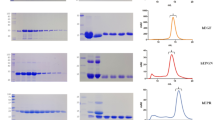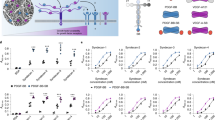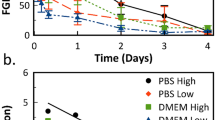Abstract
Successful use of growth factois in therapeutic and bioprocessig application requires overcoming two attenuation mechanisms: growth factor depletion and receptor down-regulation. current ameliorative strategies use physiologically inappropriate high growth-factor concentrations, along with periodic media refeeding in vitro and reinjection or controlled-release devices in vivo. We demonstrate a new approach derived from understanding how these attenuation mechanisms arise from ligand/receptor trafficking processes. Specifically, a recombinant epidermal growth factor (EGF) mutant with reduced receptor binding affinity is a more potent migogenic stimulus of fibroblasts than natural EGF or transforming growth factor alpha because of its altered trafficking properties.
This is a preview of subscription content, access via your institution
Access options
Subscribe to this journal
Receive 12 print issues and online access
$209.00 per year
only $17.42 per issue
Buy this article
- Purchase on Springer Link
- Instant access to full article PDF
Prices may be subject to local taxes which are calculated during checkout
Similar content being viewed by others

References
Sporn, M., and Roberts, A.B. (eds.). 1990. Peptide growth factors and their receptors. Springer-Verlag, Berlin.
Pimental, E. 1990. Handbook of growth factors, volume II: peptlde growth factors. CRC Press, Boca Baton, FL
Wolfe, R.A. 1993. Media for cell culture, pp. 142–156 in Biotechnology, volume 3: bioprocessing. Stephanopolous, G. (ed.). VCH Publishers Inc., New York, NY.
Meyer-lngold, W. 1993. Wound therapy: growth factors as agents to promote healing. Trends Blotechnol. 11: 387–392.
Langer, R., and Vacanti, J.P. 1993. Tissue engineering. Science 260: 920–926.
Krueger, G.G., Morgan, J.R., Jorgensen, C.M., Schmidt, L, Li, H.L., Kwan, M.K., et al. 1994. Genetically modified skin to treat disease: potential and limitations. J. Invest. Dermatol. 103: 768–843.
Wiley, H.S. 1992. Receptors: topology, dynamics, and regulation, pp. 113–142 in Membrane dynamics and signaling. JAI Press Inc., Greenwich, CT.
Moody, P.C.E., and Wilkinson, A. 1990. Protein engineering. Oxford University Press, New York.
Reddy, C.C., Wells, A., and Lauffenburger, D.A. 1994. Proliferative response of fibroblasts expressing Internalization-deficient epidermal growth factor (EGF) receptors is altered via differential EGF depletion effect. Biotechnol. Prog. 10: 377–384.
Reddy, C.C., Wells, A., and Lauffenburger, D.A. 1996. Receptor-mediated effects on ligand availability influence relative mitogenic potencies of epidermal growth factor and transforming growth factor α. J. Cell. Physiol. 166: 512–522.
Tadaki, D.K., and Niyogi, S.K. 1993. The functional importance of hydropho-bicity of the tyroslne at position 13 of human epidermal growth factor in receptor binding. J. Biol. Chem. 268: 10114–10119.
French, A.R., Tadaki, D.K., Niyogi, S.K., and Lauffenburger, D.A. 1995. Intracellular trafficking of epidermal growth factor family ligands Is directly influenced by the pH sensitivity of the receptor/ligand interaction. J. Biol. Chem. 270: 4334–4340.
Chang, D.Z., Wu, Z., and Ciardelli, T.L. 1996. A point mutation in interleukin-2 that alters ligand internalization. J. Biol. Chem. 271: 13349–13355.
Chen, P., Gupta, K., and Wells, A. 1994. Cell movement elicited by the epidermal growth factor requires kinase and autophosphorylation but is separable from mitogenesis. J. Cell. Biol. 124: 547–555.
Author information
Authors and Affiliations
Rights and permissions
About this article
Cite this article
Reddy, C., Niyogi, S., Wells, A. et al. Engineering epidermal growth factor for enhanced mitogenic potency. Nat Biotechnol 14, 1696–1699 (1996). https://doi.org/10.1038/nbt1296-1696
Received:
Accepted:
Issue Date:
DOI: https://doi.org/10.1038/nbt1296-1696
This article is cited by
-
An antibody to amphiregulin, an abundant growth factor in patients’ fluids, inhibits ovarian tumors
Oncogene (2016)
-
At the crossroads: EGFR and PTHrP signaling in cancer-mediated diseases of bone
Odontology (2012)
-
Feedback regulation of EGFR signalling: decision making by early and delayed loops
Nature Reviews Molecular Cell Biology (2011)
-
T helper type 2 differentiation and intracellular trafficking of the interleukin 4 receptor-α subunit controlled by the Rac activator Dock2
Nature Immunology (2007)
-
EGF–ERBB signalling: towards the systems level
Nature Reviews Molecular Cell Biology (2006)


